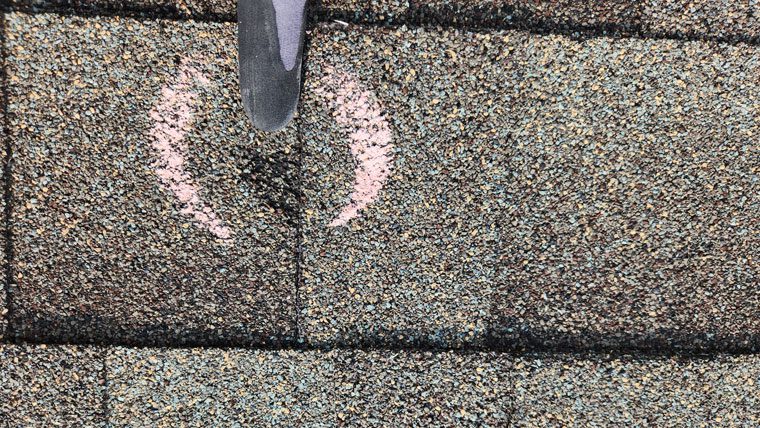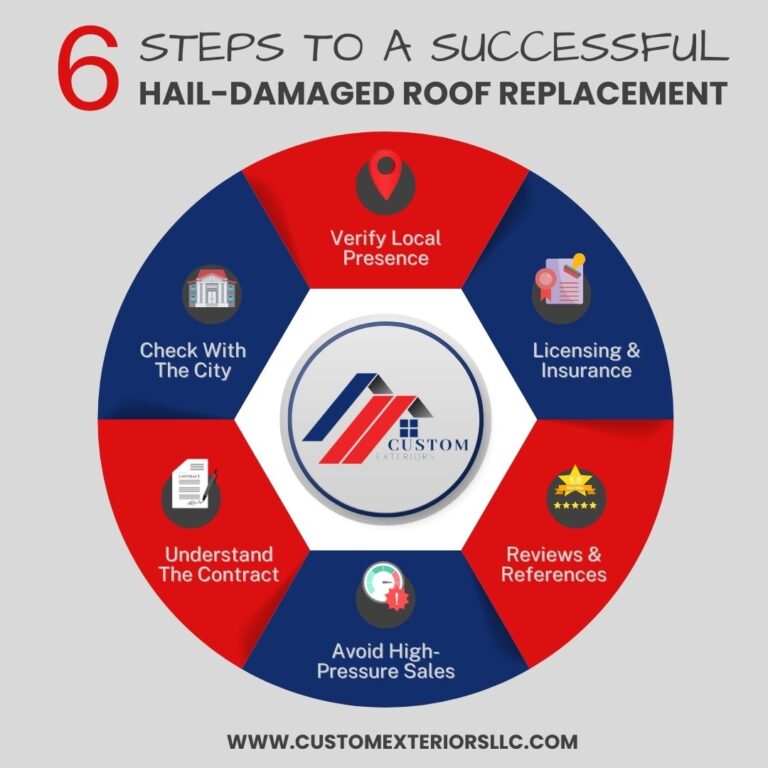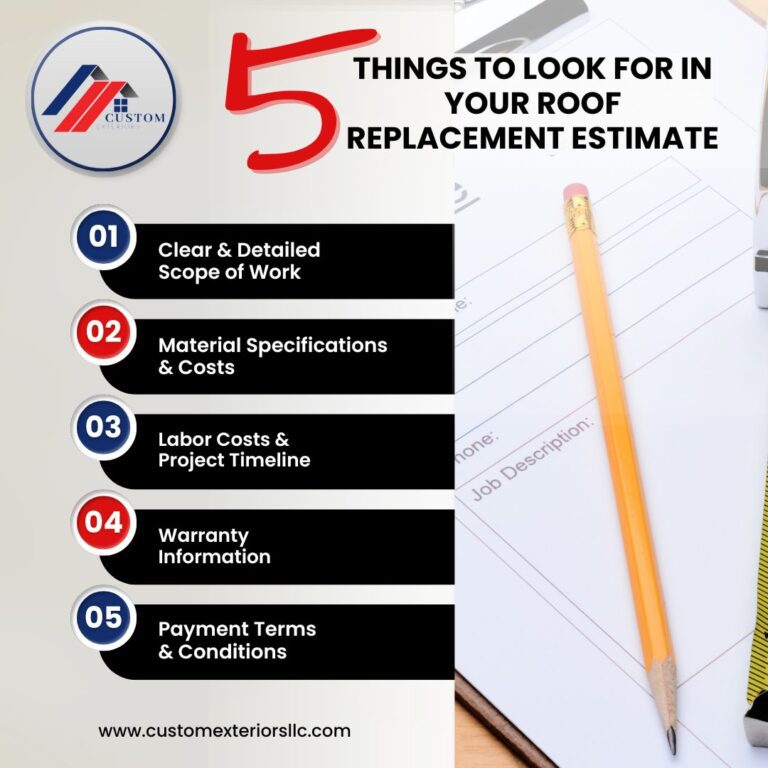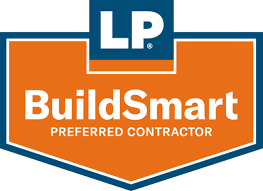
- Custom Exteriors
- August 21, 2024
Tips from a hail damage roofing contractor: Ensuring Effective hail damage roof repair
As a Colorado native and a roofing company, we know all too well that hail damage in Colorado can be severe. Most in the roofing industry remember the hail storm that hit Jefferson County in May of 2017, causing $2.3 billion in property damage in Jefferson County alone. I remember it vividly. We were beginning to grow the company we had opened in 2015. My husband left to visit Cuba for a birthday and figured early May would be a safe time to go without the risk of major hail. Wrong. On May 8, 2017, the Denver Metro area was pummeled with baseball-sized hail, becoming the most damaging storm in Colorado, forcing the closure of the Colorado Mills Mall for months. It is also the second-most expensive hail storm in U.S. history. Long story long, we were swamped and overwhelmed, and the head of our roofing department was in Cuba.
While this was one of the most stressful times in my recent work history, I often consider how people’s homes were destroyed with broken windows, exterior damage everywhere, and interior water damage. Some homes and businesses even became uninhabitable. That storm taught us the importance of customer service and communication when dealing with hail damage roof repair and the time-consuming process of restoring homes and businesses to their pre-storm condition. Since that year, we have made changes to our systems and staffing to ensure that, as a hail damage roofing contractor, we are not adding to the stress these homeowners are already experiencing.
Colorado’s frequent hailstorms, often accompanied by high winds, can cause significant damage to your roof, siding, windows, and gutters. We fully understand the financial impact of hail damage on Northern Colorado homeowners because we have experienced it personally. In 2023 alone, hailstorms caused approximately $600 million in damages across Colorado, a good portion of which affected our communities. This underscores the urgent need for homeowners to be prepared for such events.
Over the last few decades, we have seen storms that leave little to no damage. We have also seen storms so severe they often require extensive repairs on multiple exterior systems including your roof, windows, gutters, and siding. This highlights how crucial it is for homeowners to have a roofing and exteriors contractor they can trust – and a solid understanding of the insurance claim process. We’re going to try and provide you with both by the end of this article.
Finding a hail damage roofing contractor
I limped through those days while Mike was in Cuba, and it was extremely stressful. I could have provided better service, looking back. Since then, the Custom Exteriors roofing team has become a leading hail damage roofing contractor across Colorado, implementing strategies based on our experience to help create a stress-free roof replacement. Here are the things you should look for in a contractor if you need to replace your roof due to hail:

Verify A Local presence
Anyone who lives along the Front Range in Colorado knows about storm chasers. If you haven’t had a significant hailstorm in your neighborhood yet, storm chasers are roofing contractors who follow severe weather events, such as hailstorms, to solicit business from vulnerable homeowners. While not all storm chasers are unscrupulous, many engage in questionable practices. We have even seen these “contractors” collecting payments from entire neighborhoods and vanishing.
A legitimate, local roofing contractor should have a local office and a permanent business address. Ask for their physical address and verify it. Storm chasers often set up temporary offices or use P.O. boxes, making it hard to track them down later if issues arise. Check if the contractor has a local phone number and a record of operating in your area for several years. Another simple step is checking your local BBB. Most reputable roofing companies will be registered with their local BBB.
Check Licensing and Insurance
The contractor needs to be properly licensed and insured to work in your city. Most local jurisdictions require licensing through them. To obtain a license, the contractor will typically need to have passed the ICC (International Code Counsel) test on roofing, be able to provide verifiable experience and provide licenses through other jurisdictions. Roofing contractors will also have to provide proof of both workmans compensation and general liability insurance to the city. Despite this, ask for proof of insurance and verify it with the insurance provider. Legitimate contractors will be fine providing this information, while less established and trustworthy contractors might be evasive or provide incomplete documentation.
Look for reviews and references
Reputable contractors will have positive reviews and references from local customers. Check online review platforms like Google, Yelp, and their social platforms. Ask the contractor for references and follow up with past clients to hear about their experiences. If a contractor has multiple negative reviews, this could reflect poor business practices and a lack of customer service.
Be wary of high-pressure tactics
Because we are a local, licensed, reputable roofing contractor, we don’t need you to sign now! We want you to take your time and be completely comfortable with the scope of work, the associated cost, and our ability to complete your roof replacement successfully. We ask our customers to look at our online reputation and our portfolio of completed jobs. We are confident that this review will show Colorado homeowners that we are the most qualified roofing contractor for their roof replacement. There is no need for high-pressure sales tactics when your local reputation precedes you.
Door-to-door salespeople often use high-pressure sales tactics, urging you to sign a contract immediately to take advantage of “limited-time” offers or scare tactics about urgent repairs. A reputable contractor will perform tarping if necessary, give you time to make an informed decision, provide a written estimate, and explain the work that needs to be done.
Regarding those “limited-time” offers, Colorado law prohibits roofing contractors from waiving insurance deductibles as a marketing tactic. This means that homeowners must pay their deductible as outlined in their insurance policy, and contractors cannot offer to cover this cost to entice business. This law is intended to prevent fraud and ensure that claims are handled properly and ethically.
Examine the Estimate and contract closely
Additionally, Colorado law requires that contractors provide written contracts detailing the scope of work and costs, ensuring transparency.
Before signing any agreement, carefully review the contract and the estimate. Unscrupulous contractors will often try to provide “total only” estimates. These estimates do not break down services and materials but only give a total amount for your roof replacements. This allows them to add costs never incurred or inflate pricing on services rendered without justification to the homeowner. Your hail damage roof replacement estimate should include detailed information about the scope of work, materials to be used, start and completion dates, payment terms, and warranties. Avoid contractors who ask for large upfront payments or who are vague about their terms.
Check with local authorities
Contact local building authorities or state licensing boards to verify the contractor’s credentials. These organizations can provide information about the contractor’s licensing status, any complaints against them, and their reputation for passing and closing out their permits in the community.
By following these steps, you can protect yourself from storm chasers and inexperienced contractors. A little due diligence can go a long way in safeguarding your home and ensuring that any repairs are done professionally and to your satisfaction.
Most local cities have an online portal for citizens to access licensing and permit information. The City of Greeley does a great job with its Etrakit system. It is easy to use, and with a few clicks, you can verify contractor licenses and permits pulled for your address.
Filing an insurance claim after hail damage to your roof

Sometimes, like in the photo above, hail damage to your roof is large enough that you can likely identify the damage from the ground. However, there have been many instances where the roof looked intact from the ground, and upon further inspection, our team identified enough hail damage to justify a hail damage roof claim. Either way, once you and your roofing contractor have identified the need to file a claim for a hail damage roof replacement, the following steps should guide you through the process.
As a local roofing contractor, we remind our customers that your insurance company has a timeline for claim eligibility. If you wait too long, they won’t cover your damages. This timeframe is often one year from the date of loss. So, if your roof was damaged by a recent hailstorm, filing an insurance claim in a timely manner can help you cover the roof replacement costs. If you miss that window, you may be responsible for your roof replacement cost.
Assess the damage before filing a claim
The first step after a hailstorm is to inspect your property for damage. Safety comes first, so if the storm is severe, ensure there are no immediate hazards like loose shingles or broken glass. Also, remember that a roof inspection requires properly using a ladder and the ability to work at heights safely. If you have any questions about your abilities, hire a pro. If you complete the inspection, take detailed notes and photographs of all visible damage you can see from the ground. Pay special attention to the roof, but don’t neglect other areas like gutters, siding, windows, and other structures on your property. Most reputable roofing companies offer roof inspections at no cost, so this task is better left to the professionals. They know exactly what is expected during a roof inspection for an insurance claim. They can help negotiate with your insurance to ensure you are compensated adequately to return your home to its pre-storm condition.
Review Your Insurance Policy
Every season, while completing hail damage roof replacements, we never fail to run into a homeowner who unknowingly has an ACV policy. Because homeowners are sometimes unaware of their actual coverages with more concentration of monthly savings, they end up with a roofing policy that only pays a portion of the replacement. Whatever portion of the roof was depreciated will not be reimbursed upon the completion of the roof replacement like a standard RCV policy would.
Before filing a claim, it’s crucial to understand what your insurance policy covers. Policies vary significantly; you need to know your coverage limits, deductibles, and any specific exclusions. Many Northern Colorado jurisdictions require code upgrades such as replacing spaced decking or adding drip edge. If you don’t have a code upgrade clause, you may be on the hook for the costs of these upgrades. The City of Fort Collins requires upgrading to Class 4 shingles, making some code upgrades reasonably costly. Understanding what is and isn’t covered before the storm will help set your expectations for the claim process and potential out-of-pocket costs.
Contact Your insurance company
Notify your insurance company about the potential damage as soon as possible. As we discussed, many insurers have specific time frames within which you must report damage to qualify for coverage. Provide them with all the necessary details and documentation you gathered during your initial inspection or from your roofing contractor.
Schedule inspections: Insurance adjuster and roofing contractor
Your insurance company will likely send an adjuster to inspect the damage. Be present during the inspection to ensure that all damage is noted. This is also an opportunity to ask questions and understand the adjuster’s assessment process. Provide them with any additional information or documentation they might need. We make a practice of meeting the insurance representative on the job to ensure all of the damage we located is included in your claim.
Your roofing contractor will also complete an inspection that will help with claims process. Here are a few steps you should expect from them:
- Inspection and Assessment: A thorough inspection assesses the damage’s extent. Your roofing contractor and insurance representative will document the inspection through photos, videos, and notes.
- Documentation: Detailed documentation, including photographs and notes, is crucial. This helps provide evidence for insurance claims and ensures all damage is accounted for. The photos and documentation will be made available to you for review.
- Temporary Repairs: If the damage is severe and immediate repairs are necessary to prevent further damage, roofers might perform temporary fixes. This could include covering holes with tarps or applying sealant to stop leaks.
Get a roof replacement estimate

While waiting for the adjuster, getting an estimate from your roofing contractor is wise. These estimates will give you a sense of the repair costs and can be useful in negotiations with your insurance company. Make sure the contractors are experienced in handling insurance claims and can provide photographs and detailed, itemized quotes.
The estimate should be clear and concise, covering each aspect of the project in detail. It is important to remember that in Colorado, it is against the law for a homeowner to profit from an insurance claim. With this in mind, rather than focusing on the cost, focus on the contractor and their ability to complete your roof replacement. Pricing will be negotiated between the insurance company and the roofing company. Your out-of-pocket costs will be the same whether you choose the best contractor in town or the fly-by-night guy from out of state. With this in mind, use the contractor you like the most, not just the cheapest.
File Your Insurance Claim
With your contractors’ estimates in hand, you can formally file your insurance claim. Submit all required documentation and ensure that your claim form is complete and accurate. Keep copies of everything for your records.
Once your claim is processed, your insurance company will make a settlement offer. Review this offer carefully and ask for input from your roofing contractor for any questions. If it adequately covers the necessary repairs, you can hire a contractor to fix your roof. You can negotiate or appeal the decision if you believe the offer is too low. At Custom Exteriors, we help our customers negotiate with their insurance companies and ensure their home is fully restored when we complete repairs.
Complete The repairs
After agreeing on a settlement, sign a contract and hire the contractor to do the repairs. Ensure the work is completed to your satisfaction before making the final payment. Keep all receipts and documentation related to the repairs, as you may need them for future reference or additional claims.
Here is what to expect from your roofer during this time:
- Total Roof Replacement or Repair: Contractors should be careful not to damage your siding and landscaping during this process, keep open communication about the next steps, and thoroughly clean up the site afterward.
- Repair or Replace Damaged Roof Flashings and Gutters: Roofers should also repair or replace damaged flashing and gutters. Flashing around chimneys, vents, and skylights can be particularly vulnerable to hail, and repairing these areas is crucial to prevent leaks.
- Passing a Final Inspection: Once repairs are completed, a final inspection by your insurance company and/or city or county municipality ensures that all damage has been addressed and that the roof is in good condition. This also provides an opportunity to make sure the repairs meet both the homeowner’s and insurance company’s standards.
Stay Prepared
Hailstorms are a recurring issue in our area, so staying prepared is essential. Regular maintenance and inspections can help identify potential problems before they become major issues. Additionally, keeping your insurance policy up to date and understanding your coverage will ensure you’re ready for any future incidents.
Filing a roofing insurance claim after hail damage can be a complex process, but having a trusted partner and taking it step by step can help you navigate it successfully. By assessing the damage, understanding your policy, and working closely with your insurance company and Custom Exteriors, you can ensure your home is repaired with good materials and workmanship.
Contact Us Today
We Service and Support the Following Brands









Contact
Custom Exteriors, LLC
2881 S. 31st Ave, Greeley, CO 80631
109 E. 17th St. Ste 5822, Cheyenne, WY 82001
102 S. Tejon St. Ste 1100, Colorado Springs, CO 80903
404 Broadway, Eagle CO 81631
Phone: 970-460-8714
Toll Free: 800-580-0131
Quick Links
© 2022 Custom Exteriors, LLC

